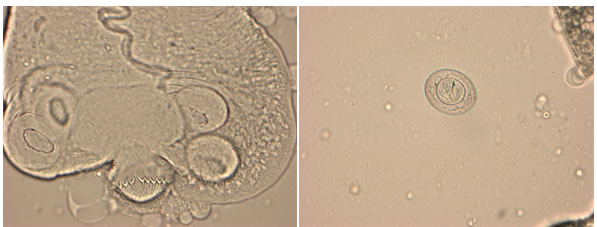Etiology: Rodentolepis nana is the dwarf tapeworm. This tapeworm is capable of infecting mice.
Incidence: The incidence of parasitism is rare.
Transmission:
Indirect cycle: Transmission occurs by ingestion of infected tissues of an intermediate host (fleas, flour beetles, cockroaches). The prepatent period is 18 – 20 days.
Direct cycle: Transmission occurs by ingestion of infective eggs. The prepatent period is 10 – 20 days.
Autoinfection: The entire life cycle occurs in the small intestine of the host.
Distribution: Lower 1/3 of small intestine. In autoinfections, immature forms may be found in the upper small intestine.
Clinical Signs: Usually there are no external signs of infection. However, catarrhal enteritis, diarrhea, emaciation and chronic weight loss may occur with heavy infestations.
Diagnosis:
Antemortem: Fecal flotation of ova.
Postmortem: Examination of small intestinal lining and/or histopathology for adult cestodes.
Diagnostic morphology:

Adults: Rodentolepis nana adults range from 25 to 40 mm long and less than l mm wide and have an armed rostellum (see photo, left). Since R. nana can complete its life cycle without an intermediate host, strobelocerci may be observed within the lamina propria of the small intestine.
Ova: 40 – 60 µm, oval shaped, with 2 membranes and 3 pairs of polar filaments arising from the inner membrane (see photo, right).
Public Health Significance: R. nana is a documented zoonotic parasite.